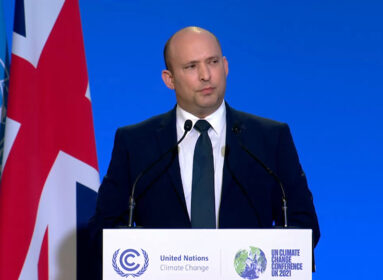
By Deborah Fineblum Schabb/JNS.org
As winter arrives and the days grow shorter, outdoor lighting is needed more during the Chanukah season than at any other time of year. This need is taken particularly seriously in Israel, where outdoor menorahs make a nocturnal stroll through city streets a treat for the eyes—and for the spirit.
The outdoor Chanukah menorah was one Israeli tradition that painters Israel Hershberg and Yael Scalia Hershberg embraced when they made aliyah from Baltimore more than three decades ago. Each year, they place nine shot glasses filled with olive oil (and each topped with a wick) in a simple box fashioned of brass and tin. The box has glass windows and little chimneys.
“It’s something of a Yerushalmi (Jerusalemite) artifact since it seems they don’t make them anymore,” Yael says of the box, which was purchased from a craftsman in the Jerusalem neighborhood of Mea Shearim. “It’s very old world, and in its authenticity and its simplicity it has real charm.”
The term menorah itself can be cause for confusion, even in Israel. The one used thousands of years ago in the Jewish Temple, which was adopted as a symbol of the nascent state of Israel, has seven branches. But the Chanukah menorah has nine branches—one for each day the scarce oil burned in the reclaimed temple more than 2,000 years ago, as well as a “shamash” to light the rest of the candles and stand guard over them as they burn.
In an effort to stem the confusion, in the late 1800s Eliezer ben Yehuda, the father of the modern Hebrew language, coined the term “chanukiah,” which is how today’s Israelis tend to refer to Chanukah menorahs.
But not all chanukiahs are outdoor affairs. Many of the 70-plus chanukiahs in the home of Tel Aviv collector Bill Gross and his wife Lisa are just too gorgeous—and too valuable—to expose to the elements.
Gross, however, is intent on “seeing them returned to their original use,” which is why he uses a different chanukiah each year. The rotation includes the 1950 Israeli specimen he used growing up in Minneapolis. “I believe that as soon as you look at them as art objects, it rips them up by their roots. These are objects made for performing a mitzvah and it’s only right to let them do that,” he says.
Old chanukiahs also serve as a reminder of those years when the act of lighting them was a risky undertaking. One chanukiah, dating back to pre-World War II times, is on display in the Holocaust History Museum at Jerusalem’s Yad Vashem, where visitors can find it in the section dealing with the Nazi rise to power. Every year, members of the family who donated it—the Mansbachs—take it home to Haifa to light it for the holiday.
“The thousands of personal items in Yad Vashem’s collections help us connect with the experience of Jewish men, women, and children during the Shoah,” says Yad Vashem Chairman Avner Shalev.
Member of Knesset Rabbi Dov Lipman (Yesh Atid) and his family also use a chanukiah that reminds them of this dark time in Jewish history—a replica of one constructed of nails in a concentration camp. “It was a gift for my bar mitzvah,” says Lipman, a Maryland native who now lives in Beit Shemesh. “As a people we have always used any means at our disposal to survive and to stay strong, and every year when we light this chanukiah we and our children are reminded of that.”
But not all menorahs have survived tough times. Many, like the one Jewish Agency Chairman Natan Sharansky used in a Soviet internment camp 34 years ago, remain only in the memory of those touched by their light. Back in 1980, Sharansky was one of a group of political prisoners and the only Jew. “But when I told them Chanukah was coming, everyone was very enthusiastic,” he says.

Yael Scalia Hershberg’s menorah, in which nine shot glasses filled with olive oil (and each topped with a wick) are placed in a simple box fashioned of brass and tin. Photo credit: Yael Scalia Hershberg.
One friend who worked in the wood shop fashioned a crude menorah of pressed wood from a box for Sharansky. He lit in the barracks on the first night of Chanukah and on several subsequent nights, until a KGB collaborator turned him in and the menorah was confiscated. “The head of the camp called me in and told me, ‘This is not a synagogue; you were brought here for punishment, not for praying,’” recalls Sharansky, who promptly embarked on a hunger strike.
The hunger strike made the camp leaders nervous because a commission from Moscow was expected to arrive shortly. On the last night of Chanukah, Sharansky told the head of the camp, “You want me to stop the hunger strike? You give me back my menorah and bring me nine candles. I’ll say the prayers and you say, ‘Amen.’”
Which is exactly what happened. “I prayed the day would come when we will celebrate our freedom in Jerusalem and that all our enemies will hear our prayer and say, ‘Amen,’” says Sharansky. Since the prayer was in Hebrew, the head of the camp didn’t understand a word but just kept saying “Amen.” The next day, after the commission had come and gone, Sharansky was sent back to the camp’s prison.
The light from all the menorahs throughout time continues to shine down through Jewish history, says Rabbi Shmuel Rabinowitz, the rabbi in charge of the Western Wall and other Israeli holy sites. Every year, after lighting the official Western Wall chanukiah, Rabinowitz returns home to light the small silver one his in-laws gave him for his wedding 25 years ago. “A little bit of light takes away all the darkness,” the rabbi says through a translator. “And this year, more than ever, we need the light. As a people we need to be united and together, with no fighting or disagreement. We Jews need to connect through this light to the spirit of Chanukah and to each other.”
Rabinowitz adds, “At a time of so much darkness, we need to also connect to the power of our Jewish tradition. The light has the power to bring us back to it and to unify us.”
The chanukiah at the home of Rabbi Yehoshua Fass, co-founder and executive director of the Nefesh B’Nefesh aliyah agency, came with his wife Batsheva’s grandfather all the way to America from Germany, where he purchased it after the war. “He had lost everything but gathered whatever he could to buy a semblance of Judaism which for him was a sign of rebuilding and hope,” says Fass. “And now that it has been passed down to the fourth generation in our family, it also reminds us that Jewish history is still being written and Israel is the homeland for tomorrow’s generations of our people.”
“Each night when we add a candle and the light grows steadily stronger, we realize once again the importance of being here in Israel, the only place in the world that is truly ours,” Fass adds. “Like the miracle of Hanukkah, this mini miracle of our ability to return home to Israel is something that we want to publicize to the entire Jewish world.”








 Southern New England Jewish Ledger
Southern New England Jewish Ledger









